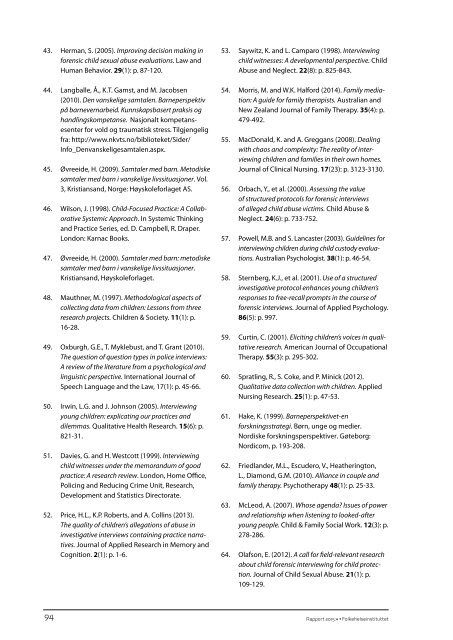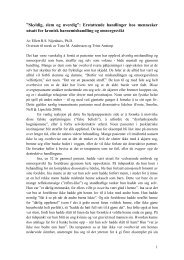rapport 2015:4
641aa6d88d
641aa6d88d
Create successful ePaper yourself
Turn your PDF publications into a flip-book with our unique Google optimized e-Paper software.
43. Herman, S. (2005). Improving decision making in<br />
forensic child sexual abuse evaluations. Law and<br />
Human Behavior. 29(1): p. 87-120.<br />
44. Langballe, Å., K.T. Gamst, and M. Jacobsen<br />
(2010). Den vanskelige samtalen. Barneperspektiv<br />
på barnevernarbeid. Kunnskapsbasert praksis og<br />
handlingskompetanse. Nasjonalt kompetansesenter<br />
for vold og traumatisk stress. Tilgjengelig<br />
fra: http://www.nkvts.no/biblioteket/Sider/<br />
Info_Denvanskeligesamtalen.aspx.<br />
45. Øvreeide, H. (2009). Samtaler med barn. Metodiske<br />
samtaler med barn i vanskelige livssituasjoner. Vol.<br />
3, Kristiansand, Norge: Høyskoleforlaget AS.<br />
46. Wilson, J. (1998). Child-Focused Practice: A Collaborative<br />
Systemic Approach. In Systemic Thinking<br />
and Practice Series, ed. D. Campbell, R. Draper.<br />
London: Karnac Books.<br />
47. Øvreeide, H. (2000). Samtaler med barn: metodiske<br />
samtaler med barn i vanskelige livssituasjoner.<br />
Kristiansand, Høyskoleforlaget.<br />
48. Mauthner, M. (1997). Methodological aspects of<br />
collecting data from children: Lessons from three<br />
research projects. Children & Society. 11(1): p.<br />
16-28.<br />
49. Oxburgh, G.E., T. Myklebust, and T. Grant (2010).<br />
The question of question types in police interviews:<br />
A review of the literature from a psychological and<br />
linguistic perspective. International Journal of<br />
Speech Language and the Law, 17(1): p. 45-66.<br />
50. Irwin, L.G. and J. Johnson (2005). Interviewing<br />
young children: explicating our practices and<br />
dilemmas. Qualitative Health Research. 15(6): p.<br />
821-31.<br />
51. Davies, G. and H. Westcott (1999). Interviewing<br />
child witnesses under the memorandum of good<br />
practice: A research review. London, Home Office,<br />
Policing and Reducing Crime Unit, Research,<br />
Development and Statistics Directorate.<br />
52. Price, H.L., K.P. Roberts, and A. Collins (2013).<br />
The quality of children’s allegations of abuse in<br />
investigative interviews containing practice narratives.<br />
Journal of Applied Research in Memory and<br />
Cognition. 2(1): p. 1-6.<br />
53. Saywitz, K. and L. Camparo (1998). Interviewing<br />
child witnesses: A developmental perspective. Child<br />
Abuse and Neglect. 22(8): p. 825-843.<br />
54. Morris, M. and W.K. Halford (2014). Family mediation:<br />
A guide for family therapists. Australian and<br />
New Zealand Journal of Family Therapy. 35(4): p.<br />
479-492.<br />
55. MacDonald, K. and A. Greggans (2008). Dealing<br />
with chaos and complexity: The reality of interviewing<br />
children and families in their own homes.<br />
Journal of Clinical Nursing. 17(23): p. 3123-3130.<br />
56. Orbach, Y., et al. (2000). Assessing the value<br />
of structured protocols for forensic interviews<br />
of alleged child abuse victims. Child Abuse &<br />
Neglect. 24(6): p. 733-752.<br />
57. Powell, M.B. and S. Lancaster (2003). Guidelines for<br />
interviewing children during child custody evaluations.<br />
Australian Psychologist. 38(1): p. 46-54.<br />
58. Sternberg, K.J., et al. (2001). Use of a structured<br />
investigative protocol enhances young children’s<br />
responses to free-recall prompts in the course of<br />
forensic interviews. Journal of Applied Psychology.<br />
86(5): p. 997.<br />
59. Curtin, C. (2001). Eliciting children’s voices in qualitative<br />
research. American Journal of Occupational<br />
Therapy. 55(3): p. 295-302.<br />
60. Spratling, R., S. Coke, and P. Minick (2012).<br />
Qualitative data collection with children. Applied<br />
Nursing Research. 25(1): p. 47-53.<br />
61. Hake, K. (1999). Barneperspektivet-en<br />
forskningsstrategi. Børn, unge og medier.<br />
Nordiske forskningsperspektiver. Gøteborg:<br />
Nordicom, p. 193-208.<br />
62. Friedlander, M.L., Escudero, V., Heatherington,<br />
L., Diamond, G.M. (2010). Alliance in couple and<br />
family therapy. Psychotherapy 48(1): p. 25-33.<br />
63. McLeod, A. (2007). Whose agenda? Issues of power<br />
and relationship when listening to looked-after<br />
young people. Child & Family Social Work. 12(3): p.<br />
278-286.<br />
64. Olafson, E. (2012). A call for field-relevant research<br />
about child forensic interviewing for child protection.<br />
Journal of Child Sexual Abuse. 21(1): p.<br />
109-129.<br />
94<br />
Rapport <strong>2015</strong>:4 • Folkehelseinstituttet



